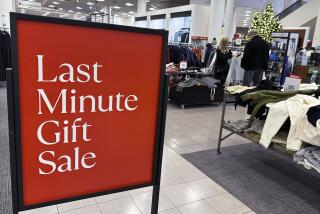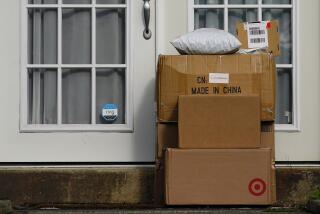Christmas delivery woes stack up for online merchants
The crush of last-minute online shopping that stymied Christmas deliveries for thousands of people served as a harsh lesson to retailers and shippers: The ever-exploding number of Internet orders is making on-time distribution more difficult.
Though cybershopping still is a small part of overall retail sales, companies eager to lure customers to the new frontier are adding to the pressure by touting same-day delivery options in many areas.
But the difficulties that FedEx Corp. and United Parcel Service Inc. faced in distributing packages promised by Christmas Eve suggest that retailers and shippers need to work out kinks in the process before delving more deeply into the digital realm.
On Sunday, Booz & Co. Chief Retail Strategist Thom Blischok ordered china for his wife on EBay Inc.’s website, expecting the U.S. Postal Service to deliver it Tuesday afternoon. It didn’t arrive until Thursday, so Blischok made do over the holiday with a gift of a photo of the item.
The delay, he said, is a sign of suddenly overwhelming Internet shopper traffic.
“The online environment this year was absolutely phenomenal,” he said. “It caught fire, more than anyone could have ever predicted.”
E-commerce retailers have had a banner year, with online sales rising more than 16% year over year on Christmas Day alone, according to IBM Digital Analytics Benchmark.
Amazon.com Inc. said it had its best holiday ever, with 36.8 million items ordered worldwide on Cyber Monday, the equivalent of 426 items a second. The company also said that more than 1 million people became members of its Prime service in the third week of December — a new high for any week.
Customers have been increasingly drawn to the convenience of online shopping, especially as reports of Christmas Eve fights at crowded malls dotted social media sites.
Even chains with a heavy physical footprint are strengthening what Blischok called the “bricks and clicks” strategy, blending their store operations with their digital sites to capture a wider range of shoppers.
Though many retailers offered “buy online, pick up in-store” deals, consumers often found it more convenient to browse, buy and ship from their computers in one fell swoop.
Internet consumers also tend to believe that better deals are found online than at bricks-and-mortar retailers. Companies cooperated by flooding email inboxes and plastering their websites with online-only specials this year.
Procrastination also played a part in the delivery debacle for this year’s holiday season.
As of Sunday, shoppers still had nearly 17% of their gifts left to buy, according to a survey from the International Council of Shopping Centers.
Retailers that needed to cut overstocked inventories baited last-minute shoppers with free and low-cost expedited shipping offers.
Internet orders make up only 5.8% of total retail sales, according to the National Federation of Retailers. But they have helped lift total industry revenue for Nov. 1 to Dec. 24 a “decent” 3.5%, compared with the same period last year, according to a Thursday report from MasterCard SpendingPulse. Sales in holiday-related categories such as apparel, electronics and jewelry swelled 2.3%.
The moderate overall growth was tamped down by a shorter shopping period between Thanksgiving and Christmas, with six fewer days than last year, researchers said. Stormy weather during the final two weekends of the season — normally key consumption time for procrastinating gift-buyers — also hurt bricks-and-mortar retailers.
“One clear bright spot is that many consumers who were stuck indoors turned to online shopping to check items off their list,” said Sarah Quinlan, senior vice president of market insights for MasterCard Advisors.
But popularity demands resources, and experts worried that companies are at a crossroads between their desire for strong online sales and their ability to deliver on orders.
Consumers whose presents arrived after the holiday railed against delivery companies and vowed boycotts. Amazon.com said it was reviewing the carriers’ performance, even as it refunded shipping charges for affected customers and offered $20 gift cards to them.
On Thursday, FedEx said it would work with customers to “address any isolated incidents.” The company had predicted earlier that it would move more packages this year than last, with the 85 million parcels it handled from Dec. 1 to 7 representing a 13% increase from the busiest week last year.
The U.S. Postal Service said it was unaffected by shipment delays, even as holiday package volume boomed 19% over the same period last year. It delivered more than 75,000 packages on Christmas Day.
UPS also expected the holidays to be more hectic this year, forecasting that daily volume during its peak season would swell 8% year over year. The company will give affected customers a refund and will work Thursday and Friday to deliver packages that missed their Dec. 24 delivery deadline — a “small percentage,” said spokeswoman Natalie Black.
“We’re sorry that packages didn’t get delivered by Christmas Eve, but it’s been all hands on deck,” Black said.
Moody’s analyst Charlie O’Shea said he received his wife’s Christmas present on time only because he was tracking its progress on a FedEx smartphone app. On Christmas Eve, he noticed that the item had been rerouted from the delivery truck back to the distribution depot, which was 10 minutes from his house.
He jumped into his car around 8 p.m. and retrieved it himself.
“Everyone’s trying to do a better job online, and the better they do, the more volume they have, and the more issues the third-party carriers are going to have handling it,” O’Shea said.
Analysts said retailers may start contracting with shipping firms for more capacity, demanding more dedicated planes and trucks from the likes of UPS during heavy load periods.
O’Shea said chains already in control of most of their distribution systems — with in-house fulfillment centers and company-run fleets — may someday decide to deliver directly to shoppers.
“We’re blazing new trails here,” he said. “It’s really a grab-bag right now, but at some point, the bricks-and-mortar guys may get control over that last mile of delivery.”
Twitter: @tiffhsulatimes, @rljourno
More to Read
Inside the business of entertainment
The Wide Shot brings you news, analysis and insights on everything from streaming wars to production — and what it all means for the future.
You may occasionally receive promotional content from the Los Angeles Times.












